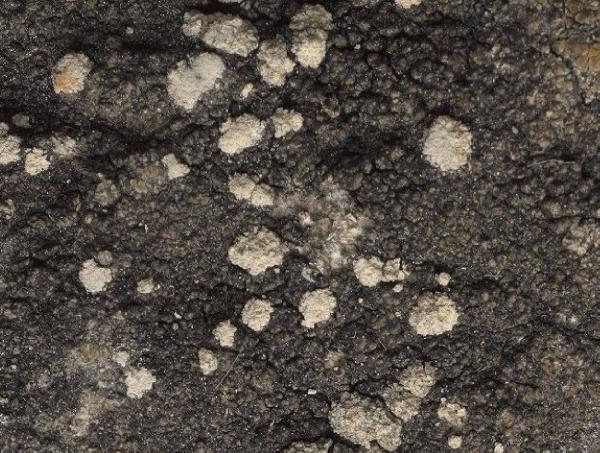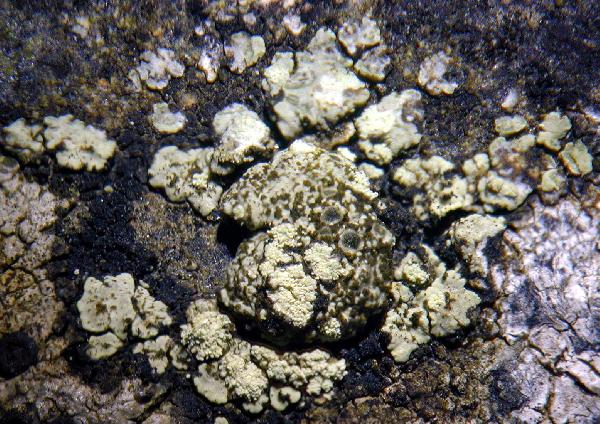Lecanora soralifera (Suza) Räsänen
Ann. Acad. Sci. Fenn., ser. A, 34: 84, 1931. Basionym: Lecanora intricata var. soralifera Suza - J. Sborn. Klub, prirod. Brno, 4: 17, 1922.
Synonyms: Lecanora efflorescens (Cromb.) Lettau; Lecanora polytropa f. efflorescens Cromb.
Distribution: N - Frl (Tretiach & Hafellner 2000), Piem (Isocrono & al. 2003, Giordani & al. 2014).
Description: Thallus crustose, episubstratic, pale yellow-green to green-grey, more rarely darkening to green-brown or green-black, areolate, forming more or less well-delimited, up to 2 cm wide patches. Areoles flattened, the marginal ones sometimes almost subsquamulose, often with crenulated margins, bearing 1-2 mm wide, laminal, discrete and circular to confluent, whitish to greenish white soralia which are usually slightly paler than thallus; soredia 30-50 µm. Apothecia rare, lecanorine, 0.2-0.5 mm across, sessile, with a flat to slightly convex, yellowish to green- or brown-black disc, and an entire to crenulate, finally excluded thalline margin. Epithecium brown, without crystals; hymenium colourless; paraphyses simple or sparingly branched in upper part, with slightly swollen apices; hypothecium colourless. Asci 8-spored, cylindrical-clavate, Lecanora-type. Ascospores 1-celled, hyaline, ellipsoid, 7-13 x 4-7 μm. Photobiont chlorococcoid. Spot tests: thallus K- or K+ weakly yellow, C-, KC+ yellow, P-, UV+ dull orange. Chemistry: usnic acid, zeorin.Note: on iron-rich rocks, including pebbles, in upland areas; certainly more widespread in the Alps. A dubious record from Latium (see Nimis 1993: 369) is not accepted here.
Growth form: Crustose
Substrata: rocks
Photobiont: green algae other than Trentepohlia
Reproductive strategy: mainly asexual, by soredia, or soredia-like structures (e.g. blastidia)
Most common in areas with a humid-warm climate (e.g. most of Tyrrenian Italy)
Species of metal-rich rocks
Pioneer species
Commonnes-rarity: (info)
Alpine belt: very rare
Subalpine belt: rare
Oromediterranean belt: absent
Montane belt: very rare
Submediterranean belt: absent
Padanian area: absent
Humid submediterranean belt: absent
Humid mediterranean belt: absent
Dry mediterranean belt: absent

Predictive model
Herbarium samples
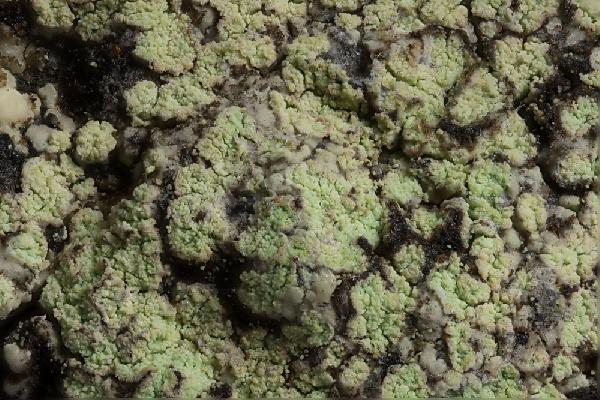
Ulrich Kirschbaum CC BY-SA 4.0 - Source: https://www.thm.de/lse/ulrich-kirschbaum/flechtenbilder
Central Europe: Germany. (Coll/ident: D. Teuber).. On siliceous rocks
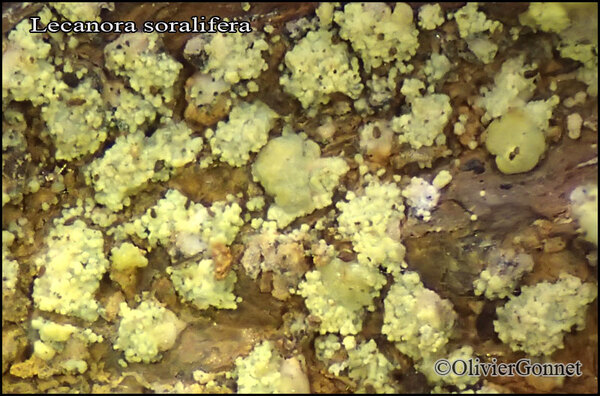
Courtesy Danièle et Olivier Gonnet - Source: https://www.afl-lichenologie.fr/Photos_AFL/Photos_AFL_L/Texte_L_4/Lecanora_soralifera.htm
France, Gorges du Sègre, alt. 1600 m, Lio - Pyrénées-Orientales - (66) - trouvé sur schistes silicatés, riches en métaux.
12/08/2012
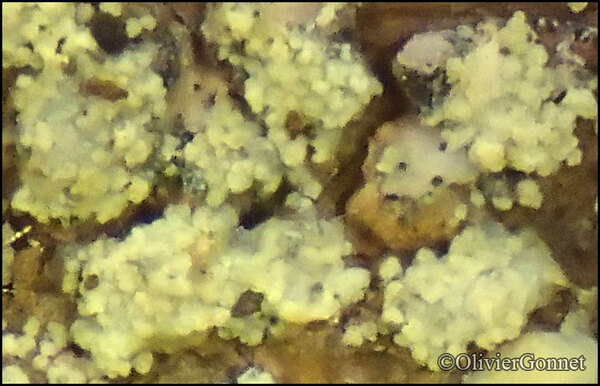
Courtesy Danièle et Olivier Gonnet - Source: https://www.afl-lichenologie.fr/Photos_AFL/Photos_AFL_L/Texte_L_4/Lecanora_soralifera.htm
France, Gorges du Sègre, alt. 1600 m, Lio - Pyrénées-Orientales - (66) - trouvé sur schistes silicatés, riches en métaux.
12/08/2012

Courtesy Danièle et Olivier Gonnet - Source: https://www.afl-lichenologie.fr/Photos_AFL/Photos_AFL_L/Texte_L_4/Lecanora_soralifera.htm
France, Gorges du Sègre, alt. 1600 m, Lio - Pyrénées-Orientales - (66) - trouvé sur schistes silicatés, riches en métaux.
12/08/2012
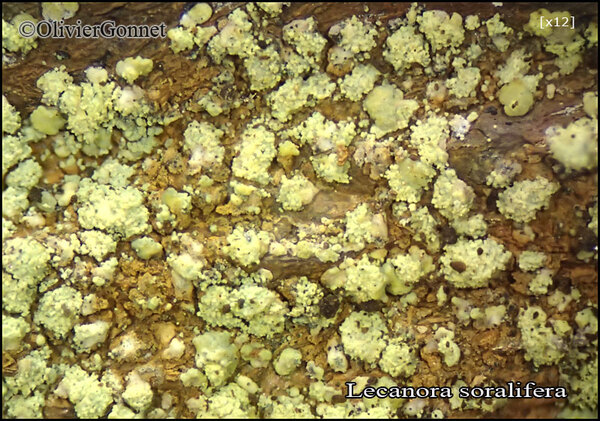
Courtesy Danièle et Olivier Gonnet - Source: https://www.afl-lichenologie.fr/Photos_AFL/Photos_AFL_L/Texte_L_4/Lecanora_soralifera.htm
France, Gorges du Sègre, alt. 1600 m, Lio - Pyrénées-Orientales - (66) - trouvé sur schistes silicatés, riches en métaux.
12/08/2012
Growth form: Crustose
Substrata: rocks
Photobiont: green algae other than Trentepohlia
Reproductive strategy: mainly asexual, by soredia, or soredia-like structures (e.g. blastidia)
Most common in areas with a humid-warm climate (e.g. most of Tyrrenian Italy)
Species of metal-rich rocks
Pioneer species
Commonnes-rarity: (info)
Alpine belt: very rare
Subalpine belt: rare
Oromediterranean belt: absent
Montane belt: very rare
Submediterranean belt: absent
Padanian area: absent
Humid submediterranean belt: absent
Humid mediterranean belt: absent
Dry mediterranean belt: absent

Predictive model
| Herbarium samples |

Ulrich Kirschbaum CC BY-SA 4.0 - Source: https://www.thm.de/lse/ulrich-kirschbaum/flechtenbilder
Central Europe: Germany. (Coll/ident: D. Teuber).. On siliceous rocks

Courtesy Danièle et Olivier Gonnet - Source: https://www.afl-lichenologie.fr/Photos_AFL/Photos_AFL_L/Texte_L_4/Lecanora_soralifera.htm
France, Gorges du Sègre, alt. 1600 m, Lio - Pyrénées-Orientales - (66) - trouvé sur schistes silicatés, riches en métaux.
12/08/2012

Courtesy Danièle et Olivier Gonnet - Source: https://www.afl-lichenologie.fr/Photos_AFL/Photos_AFL_L/Texte_L_4/Lecanora_soralifera.htm
France, Gorges du Sègre, alt. 1600 m, Lio - Pyrénées-Orientales - (66) - trouvé sur schistes silicatés, riches en métaux.
12/08/2012

Courtesy Danièle et Olivier Gonnet - Source: https://www.afl-lichenologie.fr/Photos_AFL/Photos_AFL_L/Texte_L_4/Lecanora_soralifera.htm
France, Gorges du Sègre, alt. 1600 m, Lio - Pyrénées-Orientales - (66) - trouvé sur schistes silicatés, riches en métaux.
12/08/2012

 INDEX FUNGORUM
INDEX FUNGORUM
 GBIF
GBIF
 DOLICHENS
DOLICHENS



